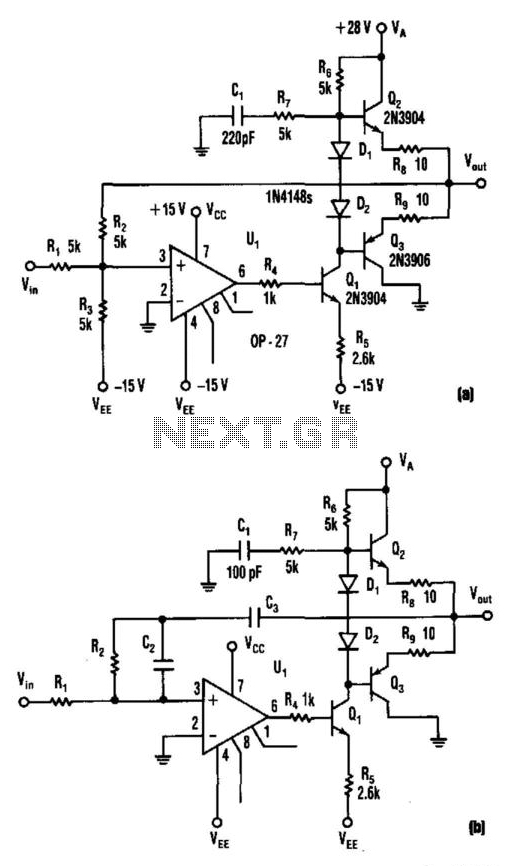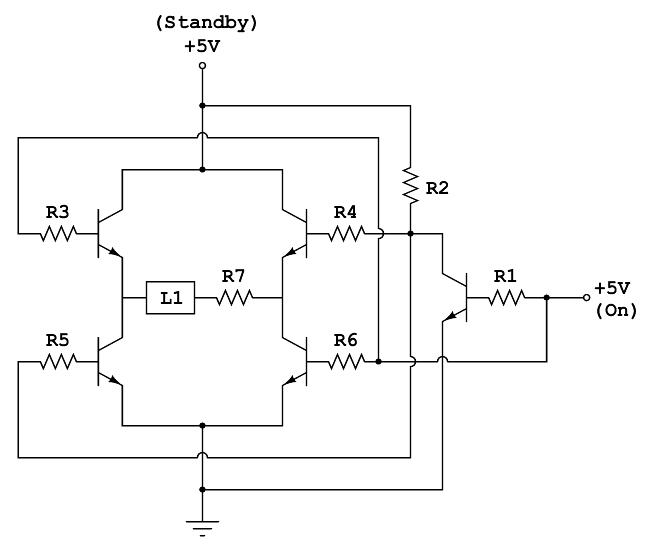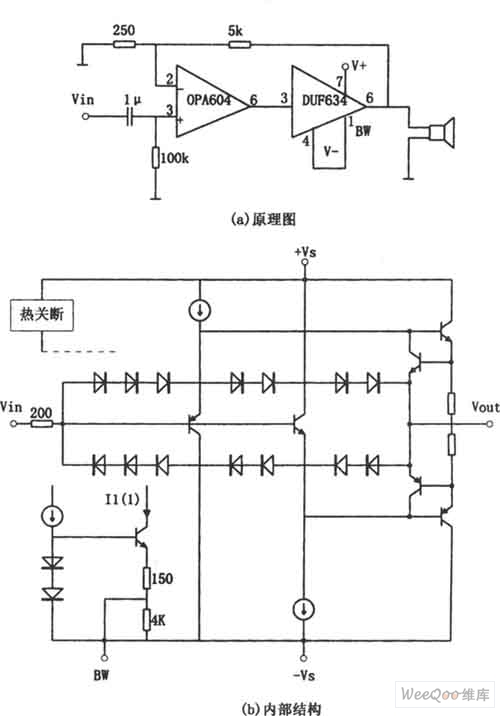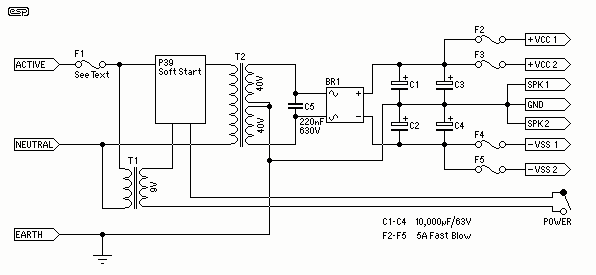
Compound Op Amp Vco Driver

This circuit produces a 5 to 25 V output to drive a voltage-controlled oscillator (VCO) from a standard ±15 V supply system. Resistor R7 and capacitor C1 provide frequency compensation. Transistors Q1 through Q3 form an inverting amplifier with a gain of two. Negative feedback through resistor R2 closes the loop. This circuit can act as an active load-log filter and directly drive a voltage-controlled oscillator.
The described circuit is designed to generate an adjustable output voltage ranging from 5 V to 25 V, utilizing a standard dual power supply of ±15 V. The primary function of this circuit is to interface with a voltage-controlled oscillator (VCO), making it suitable for applications in frequency modulation and signal processing.
The components R7 and C1 are integral to the circuit's stability, providing frequency compensation to ensure that the amplifier operates effectively across its intended frequency range. This compensation helps mitigate potential oscillations or instability that could arise from the feedback loop.
Transistors Q1, Q2, and Q3 are configured as an inverting amplifier, achieving a voltage gain of two. This configuration allows the circuit to amplify the input signal while inverting its phase. The gain is determined by the values of the resistors in the feedback loop, with R2 playing a crucial role in establishing the negative feedback necessary for stable operation. The feedback mechanism ensures that the output voltage remains proportional to the input voltage, thus maintaining linearity.
The circuit's ability to function as an active load-log filter is significant for applications requiring precise signal conditioning. By employing this configuration, the circuit can filter out unwanted frequency components while allowing the desired signal to pass through, making it an effective tool for signal processing tasks.
In summary, this circuit not only provides a variable output voltage suitable for driving a VCO but also incorporates features that enhance its stability and performance in various electronic applications. Its design allows for efficient signal amplification and filtering, making it a versatile component in many electronic systems. This circuit produces 5- to 25-V output to drive a VCO from a standard ± 15-V supply system. R7 and CI supply fr equency compensation. Ql through Q3 form an inverting amplifier with a gain of two. Negative feedback through R2 closes the loop. This circuit can act as a an active load-log filter and directly drive a voltage-controlled oscillator.
The described circuit is designed to generate an adjustable output voltage ranging from 5 V to 25 V, utilizing a standard dual power supply of ±15 V. The primary function of this circuit is to interface with a voltage-controlled oscillator (VCO), making it suitable for applications in frequency modulation and signal processing.
The components R7 and C1 are integral to the circuit's stability, providing frequency compensation to ensure that the amplifier operates effectively across its intended frequency range. This compensation helps mitigate potential oscillations or instability that could arise from the feedback loop.
Transistors Q1, Q2, and Q3 are configured as an inverting amplifier, achieving a voltage gain of two. This configuration allows the circuit to amplify the input signal while inverting its phase. The gain is determined by the values of the resistors in the feedback loop, with R2 playing a crucial role in establishing the negative feedback necessary for stable operation. The feedback mechanism ensures that the output voltage remains proportional to the input voltage, thus maintaining linearity.
The circuit's ability to function as an active load-log filter is significant for applications requiring precise signal conditioning. By employing this configuration, the circuit can filter out unwanted frequency components while allowing the desired signal to pass through, making it an effective tool for signal processing tasks.
In summary, this circuit not only provides a variable output voltage suitable for driving a VCO but also incorporates features that enhance its stability and performance in various electronic applications. Its design allows for efficient signal amplification and filtering, making it a versatile component in many electronic systems. This circuit produces 5- to 25-V output to drive a VCO from a standard ± 15-V supply system. R7 and CI supply fr equency compensation. Ql through Q3 form an inverting amplifier with a gain of two. Negative feedback through R2 closes the loop. This circuit can act as a an active load-log filter and directly drive a voltage-controlled oscillator.





